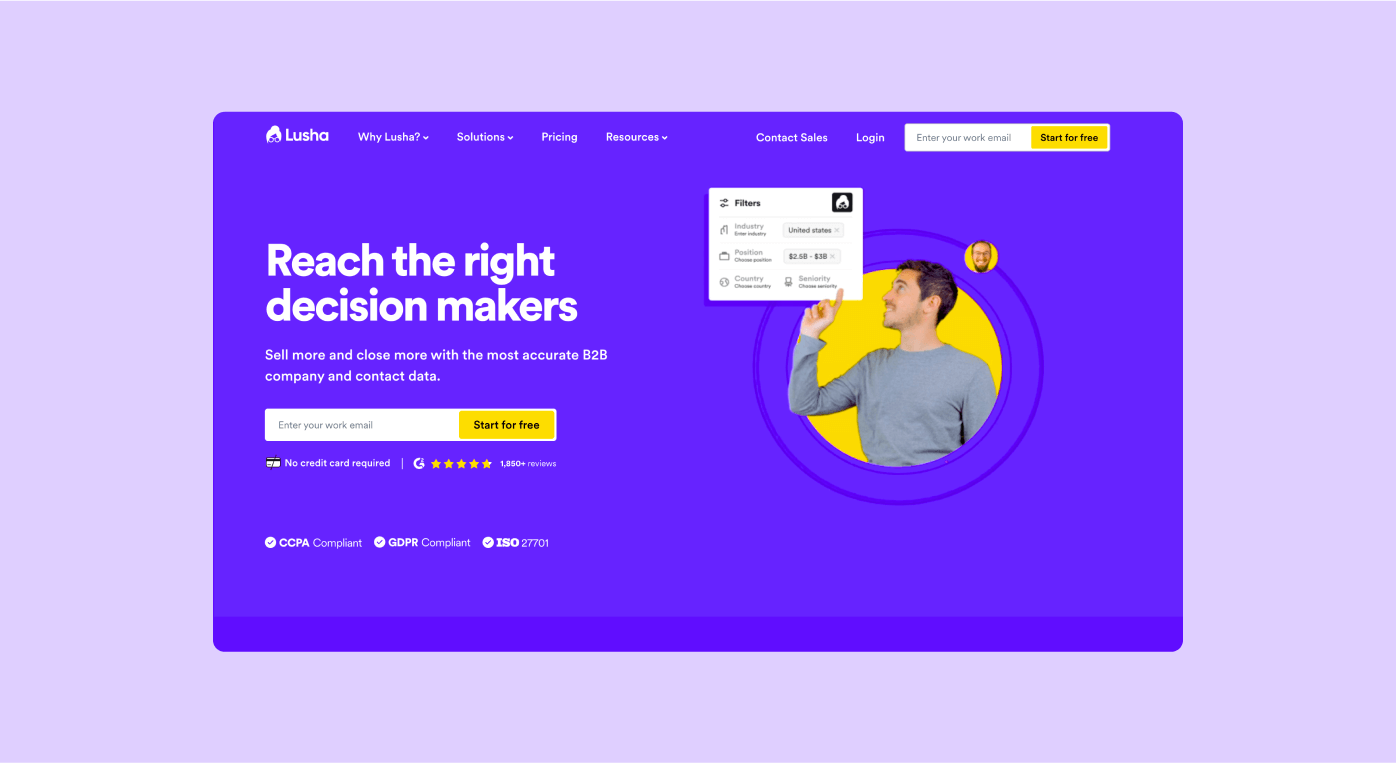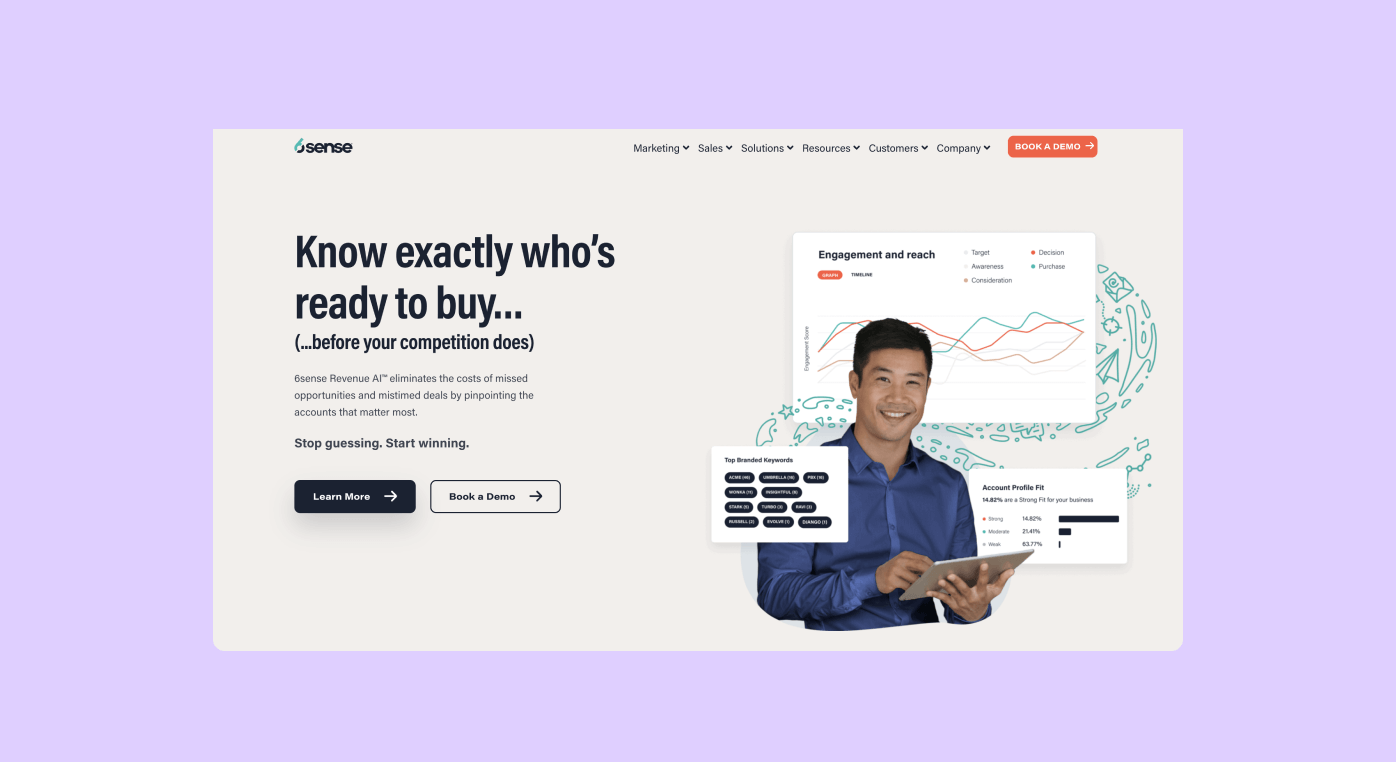We all know how tiresome it can be to move prospects through the sales funnel. That’s why more and more salespeople are turning to intent data providers. Instead of having to force your way through a prospect’s doors, intent data can open them for you. Intent data is an empowering tool not only to help you find the right prospects, but also to gain insight into where their head is at so you’re more likely to address their needs. But not every intent data provider is right for every company. They come in all shapes and sizes, and it’s important to be informed so that you choose the provider that’s the right fit.
What Is an Intent Data Provider?
Finding qualified leads is an endless challenge. Tools that recognize purchasing intent allow salespeople to focus more on the prospects that have the best chances of converting.
Of course, there are ways to collect your own intent signals, but any smart intent-based targeting campaign will also use outside providers. These providers fall into one of two categories:
- Second-party: These providers collect buying signal information for their clients through reviews and comments from users on a second-party platform. Examples include TrustRadius and Capterra (a subsidiary of Gartner).
- Third-party: These providers collect general information on companies that can be filtered into useful intent data. Some of the better known third-party providers are Dun and Bradstreet and LinkedIn.
Particularly with third-party data, it’s crucial to use techniques related to data insights and data scoring to set up a system of intent classification. After all, not every intent signal is the same, as some are stronger than others. Doing this kind of analysis produces lead information that’s filtered in a way that can be super valuable to the sales team.
How Much does Intent Data Cost?
There are countless B2B intent data providers out there, and almost just as many pricing models. Before picking a provider, first consider some basic pricing models used by third-party intent-based marketing data firms:
Per Seat
This option typically comes with a variety of features and limits on those features. For example, there are a set number of search terms that you can apply. These plans also enable monitoring of certain contact types, such as trade show attendees, industry influencers, and even competitors.
Flat Fee
With pricing as low as $200 per month, it can be relatively inexpensive to get started with some packages. On the other end, an enterprise-level subscription with the maximum number of seats can cost upwards of $8,000 per month. But the devil is in the details. For example, the $200 figure mentioned above is targeted at a user who can be more hands-on with integrating the product and doesn’t need as much guidance. Not to mention, not all intent data is created equal. Some providers will offer much more sophisticated data than others – and that usually comes with a higher cost.
Per Lead
Pricing per lead tends to be about volume – the more leads you buy, the lower the cost per lead. For this structure in particular, it is a good idea to run through a trial and make sure that a significant portion of those leads actually get you somewhere.
Part of the Package
Some firms include intent data as part of an overall package that contains many other tools. For instance, Lusha provides intent data along with other features such as a tracker for job changes and a technology stack profile – all alongside their prospecting platform with B2B contact data. It then provides users with up to 12 topics they can track for intent. This makes extra sense for sales organizations that are looking for various types of data to create a fuller picture of their prospects.
Important Pricing Considerations
Speaking of which, it’s essential to know what you are paying for. Be aware of the ways providers differ in quality:
Contact details. Some vendors give you basic information like name, organization, and company phone number, while others include direct phone number and email addresses. The age of the information is also a vital issue. A good indicator of quality is the number of sources. For example, some providers might rely only on bidstream data, while others access multiple sites and other providers.
Contract period. Many intent data companies have a three-year contract period, others use a year, and still others price in quarters. A long subscription locks you into using a certain provider in an industry where technology is constantly changing, and so is effectiveness. This makes a short contract period look like a safer bet, but some vendors will give you a discount if you sign up for a longer contract.
Support. Intent data is a relatively new thing, and using it properly takes knowledge, so onboarding is pretty important. Some software is relatively easy to use, while other types are more complicated. But in either case, a decent provider will have a great introductory program and deliver extensive support.
Filters. New users might be overwhelmed with contacts, and they’ll need a good set of filters. Some providers allow you to input ideal customer profiles and filter accordingly. It’s also really convenient for filtered data to be rendered in a format that allows easy transfer to the marketing stack.
Packages. Many vendors supply intent data as part of a larger software package, so you’ll be paying for many features all at once. For cost-effectiveness, it’s important to get mostly tools that you will use and avoid others that you have no application for. But this can also be a great advantage. Some platforms have features that work together so that their results are highly detailed. For instance, you might combine intent data with prospecting software to figure out who in an organization is most likely the one displaying buying signals.
Top 3 B2B Intent Data Providers
After scouring the web and doing our homework, we’ve narrowed down the list to the top 3 most popular vendors. But keep in mind that every salesperson and organization has different needs. Knowing how intent data fits into your go-to-market plan, understanding what can be done with the information, and being able to find the right vendor according to your own technical abilities are all factors to think about.
1. Lusha
Lusha is a go-to-market business intelligence platform. It is used by sales and marketing teams to find up to date, high-quality data about leads and prospects. We get our outstanding intent data through a partnership with Bombora, meaning that Lusha clients get data that goes far beyond a Google search. Bombora’s information is unique because it’s collected directly from more than 5,000 sources that have consented to be part of the company’s search process. This is in comparison to “data scraping,” which has run into legal and ethical issues.
Among Lusha’s specialties are simple setup and a short onboarding process based on our intuitive dashboard. The platform easily integrates with Salesforce and other third-party vendors to automatically fit with your CRM. Customers enjoy Lusha’s ease of use and the fresh data that the platform can supply about individual contacts, including intent data at the company level. Lusha is also popular with sales teams that are using a “warm outbound” approach. Despite the quality of our output, Lusha’s pricing plans are more affordable than many other intent data providers.

2. 6sense
6sense promises to “uncover anonymous buying behavior” through a variety of means, and so is a good fit for sales organizations that rely on a multichannel approach. Users like 6sense’s intuitive interface and ability to define segments across the organization. Even though they don’t offer free trials, 6sense provides no-charge installation and is highly graded for customer support. This SaaS is very popular with mid-size companies.

3. ZoomInfo
ZoomInfo describes its intent data quality as a “360-degree view of customers.” It is a well-known prospecting tool for medium sized firms, but about a quarter of its customers are small businesses. A lot of ZoomInfo’s appeal is due to a wide range of data types and ease of use.

Key Takeaways
- Intent data providers are important for salespeople who want a better chance of finding as many quality leads as possible.
- Pricing setups include per lead, per seat, as part of a package, and flat fee, but value often comes from the features and the support behind the technology.
- Top vendors include Lusha, 6sense, and ZoomInfo.
